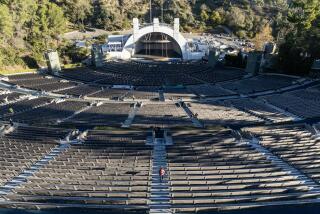Power Dip Puts Signals on Blink, Tangling Traffic at Rush Hour
A sudden dip in electrical power knocked out about 160 traffic signals Wednesday across the San Fernando Valley, triggering major traffic jams during the evening rush hour, authorities said.
At many intersections, blinking red lights brought traffic to a crawl as cars backed up for blocks. Teams from the cityâs Department of Transportation had to manually reset each signal--a drawn-out process that, three hours after the 4:10 p.m. outage, had resurrected fewer than half the affected lights.
About 6,000 Valley residents and businesses also temporarily lost power, said MaryAnne Pierson, spokeswoman for the Los Angeles Department of Water and Power. She blamed the problem on an equipment failure at the cityâs Sylmar converter station.
âThere was a dip in the voltage and it automatically trips off some systems,â including many traffic lights, Pierson said. âItâs kind of like a surge protector.â
She said the equipment failure might have been caused by lightning that struck a power transmission line near Ridgecrest.
The city restored power to homes and businesses within two hours, Pierson said. But like the traffic lights, electrical systems at some businesses still needed to be reset before they would function normally, prolonging the problem.
Gridlock virtually paralyzed many of the Valleyâs main arteries, including parts of Sepulveda Boulevard, Tampa Avenue, Victory Boulevard and Topanga Canyon Boulevard, authorities said.
âI was stuck in maddening traffic,â said Wayne Petty, a Hollywood resident who got caught in the snarl on Sepulveda, near Sherman Way. âIt took me about 20 or 30 minutes to get through the intersection. Then I jumped on the freeway and got out of there. It was insane.â
Eddie Curtis, a Department of Transportation engineer, called the delays âa necessary evil.â
Traffic signals are programmed to blink red when something--whether itâs a power outage, a storm, or an errant car--disrupts their internal controllers, he said. Once the lights start flashing, each one must be manually checked to make sure the signal timing is correctly set and that no equipment has been damaged before turning it back on.
âAll we can really do is apologize for the inconvenience,â Curtis said. âBut this happens really for public safety. If the signals didnât go into flash [mode], there could be far greater ramifications. Instead of a little delay, there could be accidents.â
No major traffic accidents were reported, police said. Unless a series of crashes snarl the same intersection, police generally leave traffic control to the Department of Transportation during power outages, said Sgt. Rod Grahek of the Los Angeles Police Departmentâs Valley Traffic Division.
âIf you take officers and put them on the corner directing traffic,â he said, âwhoâs handling the calls like the robberies and the murders and the family disputes?â
Other parts of the Los Angeles region were also zapped with unrelated power outages Wednesday. About 120,000 Southern California Edison customers briefly lost power in sections of Culver City, West Hollywood, Beverly Hills, Santa Monica and Inglewood when a crane hit a power line in Inglewood.
*
TAKING THE HEAT
Senior citizens learn how to prepare for extreme heat. B10
More to Read
Sign up for Essential California
The most important California stories and recommendations in your inbox every morning.
You may occasionally receive promotional content from the Los Angeles Times.










